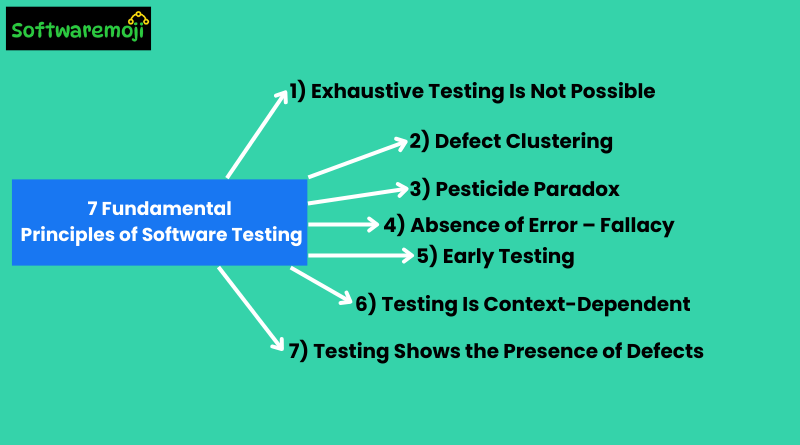
➡️7 Fundamental Principles:-
1.”Understanding the 7 fundamental principles of software testing helps businesses enhance product quality and user satisfaction while reducing costs and risks.”
2.”By applying real-life examples to software testing principles, companies can improve search engine rankings by showcasing expertise, authority, and reliability in delivering flawless digital experiences.”
➡️Introduction:-
Software testing is essential to ensure the quality and reliability of an application. However, without following a structured approach, testing can become time-consuming and ineffective. To maximize efficiency, testers follow fundamental principles that guide them in identifying defects, optimizing test efforts, and ensuring the application meets user requirements.
In this guide, we will explore the 7 Principles of Software Testing, along with practical examples to help you understand their significance.
➡️1) Exhaustive Testing Is Not Possible:-
Explanation: Testing all possible scenarios is practically impossible due to time and resource constraints. Instead, risk-based and priority-driven testing should be used to cover the most critical areas of the application.
Example: Imagine testing a file transfer process from Folder A to Folder B. The possible test cases could include:
- Moving a file when it is open.
- Insufficient user permissions.
- Folder B is full or inaccessible.
- A duplicate file exists in Folder B.
Instead of testing every scenario, testers prioritize cases with the highest risk of failure.
➡️2) Defect Clustering:
Explanation: A small number of modules typically contain the majority of defects. This follows the Pareto Principle (80/20 rule)—where 80% of the bugs are found in 20% of the system.
Example: If a banking application has 10 modules, testing might reveal that most bugs occur in the transaction processing and authentication modules. Identifying such high-risk areas helps focus testing efforts efficiently.
➡️3) Pesticide Paradox:
Explanation: Repeating the same test cases will eventually become ineffective as new defects might not be detected. To overcome this, test cases must be reviewed and updated regularly.
Example: If an e-commerce website is tested only for login functionality using the same test data, it might miss out on edge cases like:
- Special characters in usernames.
- Browser-specific login failures.
- Security vulnerabilities like SQL injection.
Testers must modify test scenarios periodically to improve defect detection.
➡️4) Testing Shows the Presence of Defects:
Explanation: Testing can confirm that defects exist, but it can never prove that an application is completely bug-free.
Example: Consider Microsoft’s public launch of Windows 98, where the system crashed during the demo. Despite extensive testing, unforeseen issues still emerged. This highlights that testing reduces defects but does not eliminate them entirely.
➡️5) Absence of Error – Fallacy:
Explanation: A system that is 99% bug-free can still fail if it does not meet user requirements. Testing should not only focus on finding defects but also ensure that the software fulfills business needs.
Example: A healthcare app that works perfectly in terms of coding and performance but does not comply with medical regulations would still be considered a failure.
➡️6) Early Testing:
Explanation: Defects should be identified as early as possible in the Software Development Life Cycle (SDLC) to reduce cost and effort.
Example: Finding a requirement error in the design phase is much cheaper than fixing it after the development stage. If an airline booking system lacks a multi-city booking feature, discovering it late would require major redesigns, increasing costs.
➡️7) Testing Is Context-Dependent:
Explanation: Testing strategies vary based on the type of application. Different domains require different testing approaches.
Example:
- E-commerce site: Focus on performance, security, and usability.
- ATM software: High priority on security and reliability.
- Medical software: Compliance with strict regulations is crucial.
➡️Conclusion:-
The 7 principles of software testing serve as a foundation for creating effective test strategies. While new methodologies and tools evolve, these principles remain timeless in ensuring software quality. By incorporating them into your testing process, you can optimize testing efforts, reduce risks, and improve application reliability.
